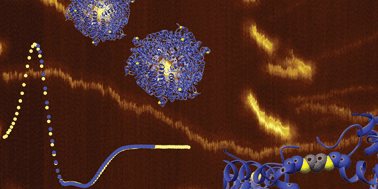Supramolecular protein polymers using mini-ferritin Dps as the building block†
Abstract
A missense mutant of a Dps protein (DNA-binding protein from starved cells) from Marinobacter hydrocarbonoclasticus was used as a building block to develop a new supramolecular assembly complex which enhances the iron uptake, a physiological function of this mini-ferritin. The missense mutation was conducted in an exposed and flexible region of the N-terminal, wherein a threonine residue in position 10 was replaced by a cysteine residue (DpsT10C). This step enabled a click chemistry approach to the variant DpsT10C, where a thiol–ene coupling occurs. Two methods and two types of linker were used resulting in two different mini-ferritin supramolecular polymers, which have maintained secondary structure and native iron uptake physiological function. Electrophoretic assays and mass spectrometry were utilized to confirm that both functionalization and coupling reactions occured as predicted. The secondary structure has been investigated by circular dichroism and synchrotron radiation circular dichroism. Size and morphology were obtained by dynamic light scattering, size exclusion chromatography and atomic force microscopy, respectively. The iron uptake of the synthesized protein polymers was confirmed by UV-Vis spectroscopy loading assays.

- This article is part of the themed collection: Supramolecular chemistry in OBC


 Please wait while we load your content...
Please wait while we load your content...